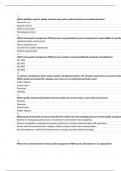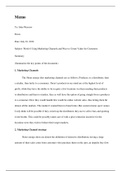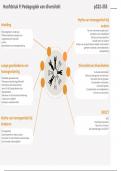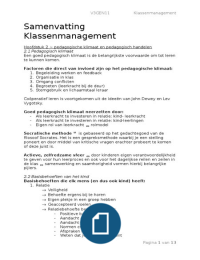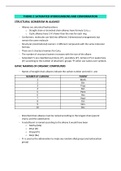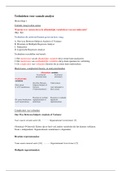CHEMISTRY NOTES
THEME 1: MATTER AND MEASUREMENT
CLASSIFICATION OF MATTER
STATES OF MATTER AND THE KINETIC-MOLECULAR THEORY
- State: whether a substance is a solid, liquid or a gas
- Matter: anything that has mass and occupies space
SOLID LIQUID GAS
Rigid shape Fluid – takes shape of Fluid – but volume of gas is
container determined by size of
container
Fixed volume – changes a Fixed volume
little when temperature/
pressure change
- Low temperature – mainly solid
- When temperature is raised solids melt to for liquids and liquids
evaporate to form gas
THE KINETIC MOLECULAR THEORY OF MATTER
- Helps interpret properties of solids, liquids, gases
- Theory explains: all matter consists of extremely small particles (atoms,
molecules or ions) that are in constant motion
SOLIDS LIQUIDS GASES
Particles packed closely Particles arranged randomly Particles are far apart
together (regular pattern) rather than in regular
patterns
Vibrate back and forth in Can move past one another Can move past one another
average positions and and move rapidly and fill
seldom move past one container
another
- There are net forces of attraction between particles in all states –
generally small in gases and large in liquids and solids
- Higher the temperature – faster particles move
- Energy of motion of particles (Ek) acts to overcome forces of attraction
between particles
, Km/h → m/s ÷ 3.6
m/s → km/h x 3.6
MATTER AT THE MACROSCOPIC AND PARTICULAR LEVELS
- Macroscopic – experiments and observations
- Sub macroscopic/ particulate – particles cannot be seen
microscopic
LEVELS OF
MATTER
particulate symbolic
- Macroscopic – observe i.e. experiment observe
- Symbolic – represent [H₂O (liquid) → H₂O (gas)]
- Particulate – imagine (use models)
- Atom: smallest representative particle of an element
- Element: sample of matter containing only one type of atom
- Molecule: smallest representative particle of a compound
: Particles consisting of 1/more atoms in which the atoms are
Held by chemical bonds
- Physical change: composition remains constant
: only on type of molecule then pure compound
,PURE SUBSTANCES
- Cannot be separated
- A Solution: Homogenous mixture of water and dissolved substances
- Pure substances have set of unique properties by which it can be
recognised
- E.g. pure water:
➢ Its colourless and odourless
➢ Look more carefully and examine and compare known properties
i.e. Melting point: 0⁰C
Boiling point: 100⁰C at atmospheric pressure
MIXTURES: HETEROGENOUS AND HOMOGENOUS
- Consists of 2/more pure substances that can be separated by physical
means
- Heterogenous:
• uneven texture can often be detected by the naked eye
• non-uniform (e.g. rack salt and copper sulfate)
- Homogenous:
• Consists of 2/more substances in the same phase (e.g. salt in
water)
• Often called solutions
- When mixtures separated into pure components the components are
said to be purified
ELEMENTS AND ATOMS
- Element: sample of matter containing only one type of atom
- Make sure to know all the different types of elements (first 92)
- Only first letter is capital when writing (e.g. Co) and when writing the
elements name out it does not have a capital unless at the beginning of
a sentence (cobalt)
- Elements encased in a box – periodic table
- Atom: smallest particle of element that retains the characteristic
chemical properties of that element
- Molecules: particles consisting of more than one atom in which the
atoms are held together by chemical bonds
, COMPOUNDS AND MOLECULES
- Chemical compound: a pure substance composed of 2/more different
elements held together by chemical bonds
- Properties of compound such as colour, hardness, and melting point are
different than those of its constituent elements
- NB – to know difference between mixture of elements and a chemical
compound of 2/more elements
- 2 major differences between pure compound and a mixture:
• Compound has distinctly different characteristics from its parent
elements
• It also has a definite percentage composition (by mass) of its
combining elements
- Definite composition (by mass) of its combining elements referred to as
law of definite properties or law of constant composition
- E.g. NaCl (table salt)
• Composed of ions: electrically charged atoms/groups of atoms
- Composition of any compound is represented by its chemical formula
THEME 1: MATTER AND MEASUREMENT
CLASSIFICATION OF MATTER
STATES OF MATTER AND THE KINETIC-MOLECULAR THEORY
- State: whether a substance is a solid, liquid or a gas
- Matter: anything that has mass and occupies space
SOLID LIQUID GAS
Rigid shape Fluid – takes shape of Fluid – but volume of gas is
container determined by size of
container
Fixed volume – changes a Fixed volume
little when temperature/
pressure change
- Low temperature – mainly solid
- When temperature is raised solids melt to for liquids and liquids
evaporate to form gas
THE KINETIC MOLECULAR THEORY OF MATTER
- Helps interpret properties of solids, liquids, gases
- Theory explains: all matter consists of extremely small particles (atoms,
molecules or ions) that are in constant motion
SOLIDS LIQUIDS GASES
Particles packed closely Particles arranged randomly Particles are far apart
together (regular pattern) rather than in regular
patterns
Vibrate back and forth in Can move past one another Can move past one another
average positions and and move rapidly and fill
seldom move past one container
another
- There are net forces of attraction between particles in all states –
generally small in gases and large in liquids and solids
- Higher the temperature – faster particles move
- Energy of motion of particles (Ek) acts to overcome forces of attraction
between particles
, Km/h → m/s ÷ 3.6
m/s → km/h x 3.6
MATTER AT THE MACROSCOPIC AND PARTICULAR LEVELS
- Macroscopic – experiments and observations
- Sub macroscopic/ particulate – particles cannot be seen
microscopic
LEVELS OF
MATTER
particulate symbolic
- Macroscopic – observe i.e. experiment observe
- Symbolic – represent [H₂O (liquid) → H₂O (gas)]
- Particulate – imagine (use models)
- Atom: smallest representative particle of an element
- Element: sample of matter containing only one type of atom
- Molecule: smallest representative particle of a compound
: Particles consisting of 1/more atoms in which the atoms are
Held by chemical bonds
- Physical change: composition remains constant
: only on type of molecule then pure compound
,PURE SUBSTANCES
- Cannot be separated
- A Solution: Homogenous mixture of water and dissolved substances
- Pure substances have set of unique properties by which it can be
recognised
- E.g. pure water:
➢ Its colourless and odourless
➢ Look more carefully and examine and compare known properties
i.e. Melting point: 0⁰C
Boiling point: 100⁰C at atmospheric pressure
MIXTURES: HETEROGENOUS AND HOMOGENOUS
- Consists of 2/more pure substances that can be separated by physical
means
- Heterogenous:
• uneven texture can often be detected by the naked eye
• non-uniform (e.g. rack salt and copper sulfate)
- Homogenous:
• Consists of 2/more substances in the same phase (e.g. salt in
water)
• Often called solutions
- When mixtures separated into pure components the components are
said to be purified
ELEMENTS AND ATOMS
- Element: sample of matter containing only one type of atom
- Make sure to know all the different types of elements (first 92)
- Only first letter is capital when writing (e.g. Co) and when writing the
elements name out it does not have a capital unless at the beginning of
a sentence (cobalt)
- Elements encased in a box – periodic table
- Atom: smallest particle of element that retains the characteristic
chemical properties of that element
- Molecules: particles consisting of more than one atom in which the
atoms are held together by chemical bonds
, COMPOUNDS AND MOLECULES
- Chemical compound: a pure substance composed of 2/more different
elements held together by chemical bonds
- Properties of compound such as colour, hardness, and melting point are
different than those of its constituent elements
- NB – to know difference between mixture of elements and a chemical
compound of 2/more elements
- 2 major differences between pure compound and a mixture:
• Compound has distinctly different characteristics from its parent
elements
• It also has a definite percentage composition (by mass) of its
combining elements
- Definite composition (by mass) of its combining elements referred to as
law of definite properties or law of constant composition
- E.g. NaCl (table salt)
• Composed of ions: electrically charged atoms/groups of atoms
- Composition of any compound is represented by its chemical formula

